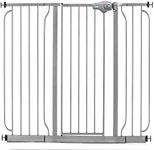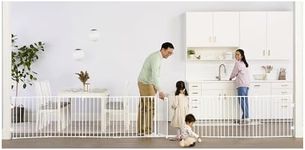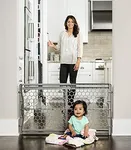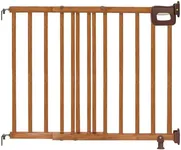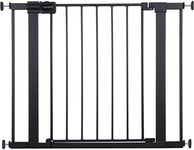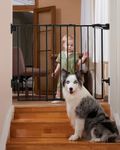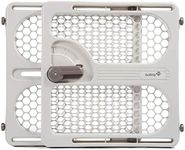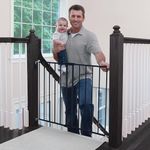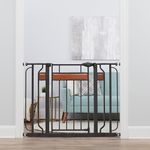Buying Guide for the Best Baby Gates
Choosing the right baby gate is an important step in making your home safer for your child. Baby gates help keep little ones away from stairs, kitchens, or other areas that might not be safe for them. When picking a baby gate, you should think about where you want to use it, how often you’ll need to open and close it, and how easy it is to install and use. Understanding the key features will help you find a gate that fits your space and your family’s needs.Type (Pressure-Mounted vs. Hardware-Mounted)The type of baby gate refers to how it is installed. Pressure-mounted gates use tension to stay in place and don’t require drilling holes, making them easy to move and install. These are best for doorways or areas where falling isn’t a risk. Hardware-mounted gates are screwed into the wall or frame, making them more secure and suitable for the top of stairs or places where safety is critical. If you need a gate for a high-risk area like stairs, always choose a hardware-mounted gate. For less risky spots or temporary use, a pressure-mounted gate is usually enough.
Width and HeightWidth and height describe the size of the gate. Gates come in different widths to fit various openings, and some are adjustable. Height is important because a taller gate is harder for a child to climb over. Measure the space where you want to put the gate and check the product’s range to make sure it will fit. If you have a particularly wide or narrow opening, look for gates that are designed for those sizes. For active toddlers or pets, a taller gate may be a better choice.
MaterialBaby gates are usually made from metal, wood, or plastic. Metal gates are sturdy and durable, making them good for high-traffic areas or for use with pets. Wooden gates can look nicer in your home but may not be as strong as metal. Plastic gates are lightweight and easy to move but might not be as durable. Think about where the gate will be used and how much wear and tear it will get. If you want something that blends in with your home, wood might be best, but for strength and durability, metal is a good choice.
Opening MechanismThe opening mechanism is how you open and close the gate. Some gates swing open like a door, while others slide or lift. Some have a one-handed release, which is helpful if you’re carrying your child. Consider how often you’ll need to go through the gate and whether you’ll usually have your hands full. If you’ll be using the gate a lot, look for one that’s easy for adults to open but hard for children.
Slat SpacingSlat spacing is the distance between the bars or panels of the gate. This is important for safety, as wide gaps can let a child’s head or body get stuck. Look for gates with narrow slat spacing to prevent accidents. If you have a very young baby or small pets, pay extra attention to this feature.
Portability and Ease of InstallationSome baby gates are designed to be moved easily from one place to another, while others are meant to stay in one spot. If you need to move the gate between rooms or take it to another house, look for a lightweight, easy-to-install model. If the gate will stay in one place, a more permanent installation might be better. Think about your lifestyle and how you’ll use the gate to decide which is right for you.
